|
Made With |
|
|
|
|
Dr. Hoffer's Travel WebSite This site was last updated 07/27/14 |
Friday July 15, 2011
Today we leave
the Province of
Notranjska in the center of the country and head to the capitol of the Province of Dolenjska
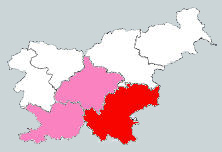 [Doh-len-ees-kah]
(red,) the southeast part of Slovenia which borders Croatia.
[Doh-len-ees-kah]
(red,) the southeast part of Slovenia which borders Croatia.
First, a little bit about this delightful city of Postojna. The area here is known to have been populated since the Paleolithic Era from discoveries in a cave settlement near the town of Postojna called Betalov spodmol (Betal Rock Shelter.) Written sources first mention the settlement in the 13th century and in 1432 it became a borough. It was proclaimed a town in 1909 and it was under Italian rule from 1918 to 1943 (nominally to 1947.) It was a commune in the province of Trieste called Postumia.
The town lies on the Pivka River (below,) a karst lost river which is 17 miles (27 Km) long. The Pivka ends in the Planina Cave (not far from here,) where it merges with the Rak River and then the Unica River. The confluence of the Pivka and the Rak is one of the largest subterranean confluences in Europe. The Pivka River created Postojna Cave which is the longest cave system in Slovenia.
.jpg)
A little about karst topography, which prior to this, I had never heard of. Karst is the term for a geological formation shaped by the dissolution of a layer or layers of soluble bedrock, usually carbonate rock such as limestone or dolomite. Though used universally, the term is derived from this area (The Karst.) Due to subterranean drainage, there may be very limited surface water, even in the absence of any rivers and lakes. Caves, sinkholes and disappearing lakes are characteristic of karst regions like we are in now. Below are stock photos of characteristic karst landscape.
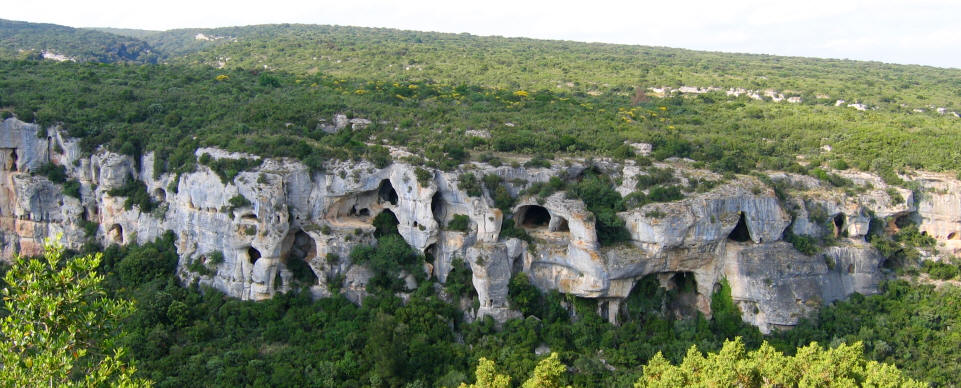
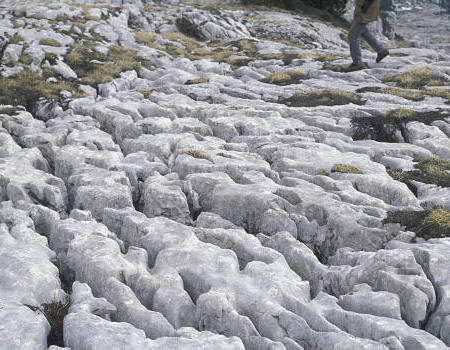
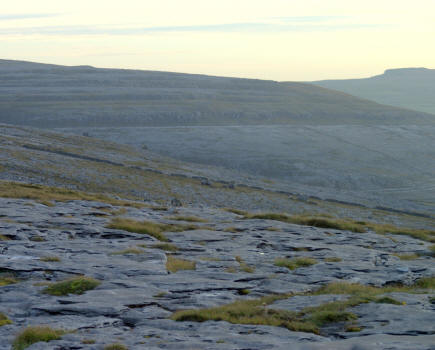
Below left is a karst lake which comes and goes, fed by underground water with no visible inlet or outlet. A karst fenster is where an underground stream emerges onto the surface between layers of rock (below right,) cascades some feet, and then disappears back down, often into a sinkhole. Rivers in karst areas may disappear underground a number of times and spring up again in different places, usually under different names (like Ljubljanica, the river of seven names.)
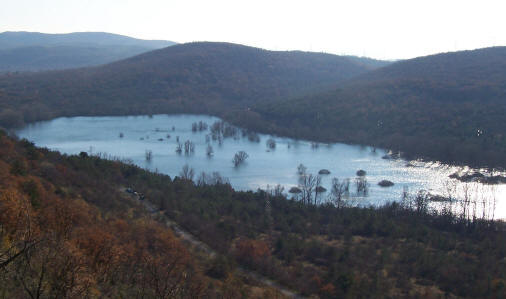
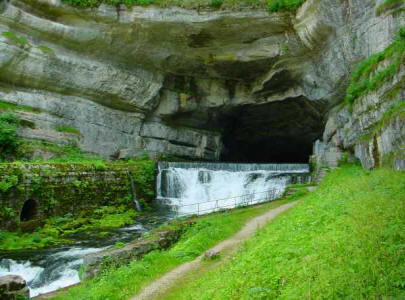
Below is an unusual karst Guilin River in China.
.jpg)
The Province of Notranjska is also known as Lower Carniola. It was part of the Middle Ages Duchy of Carniola (1364�1918) (German: Herzogtum Krain, Slovene: Vojvodina Kranjska.) Before the coming of the Romans (circa 200 BC,) the Taurisci people lived in the north of Carniola, the Pannonians in the southeast and the Iapodes or Carni (a Celtic tribe,) in the southwest. Carniola formed part of the Roman province of Pannonia; the northern part was joined to Noricum, the south-western and south-eastern parts and the city of Aemona to Venice and Istria. Below right is a map from 1815-50. You can see Styria Carinthia and Carniola and how they were divided into Austria and Slovenia.
.png)
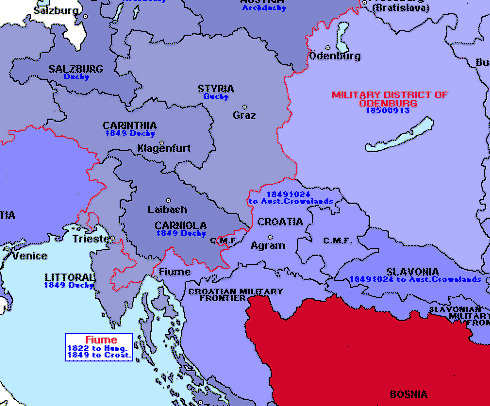
In the time of Augustus all the region from Aemona to the Kolpa River (Culpa) belonged to the province of Savia. After the fall of the Roman Empire (476,) Carniola was incorporated into the Kingdom of Italy, and in 493, under Theodoric, it formed part of the Ostrogothic Kingdom. Between the upper Sava and the Soča rivers lived the Carni, and towards the end of the 6th Century, Slavs settled the region called Carnia, or Carniola meaning "little Carnia." Later, the name was changed in Slavic to Kranjska and in German, Chrainmark or Krain. The new inhabitants, the Alpine Slavs, were subdued by the Avars, until 623 when they joined the Slavic tribal union of Samo. After Samo's death in 658 AD, they fell again under the Avar rule, but most probably enjoyed partial autonomy.
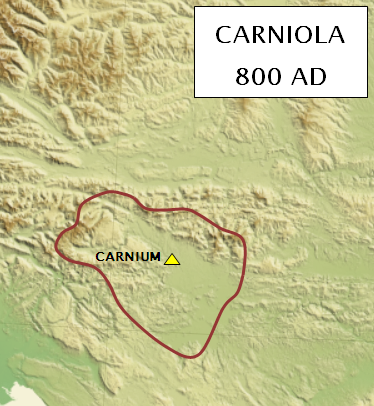
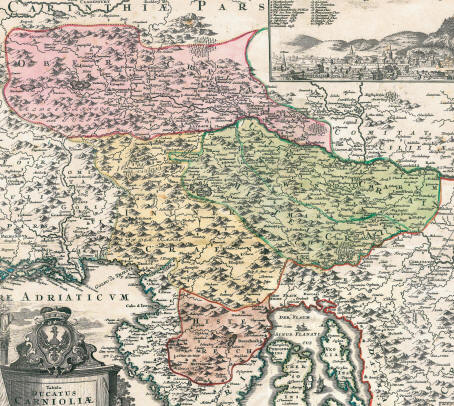
Carniola was governed by the Franks about the year 788, and was Christianized by missionaries from the Patriarchate of Aquileia. The French revolutionary troops occupied Carniola in 1797, and from 1805 to 1806, under the Treaty of Vienna, Carniola became part of the Illyrian provinces of France (1809�1814.) The Austrian Empire reorganized the territory in 1849 as a duchy in Austria-Hungary known as the Duchy of Carniola (red below.) It was bounded on the north by Carinthia (dark gray above it,) on the north-east by Styria (light gray above it,) on the south-east and south by Croatia, and on the west by Trieste, Goritza, and Istria.
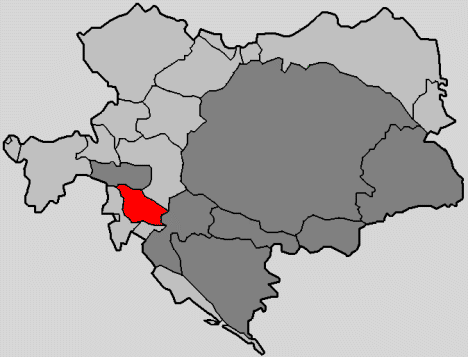
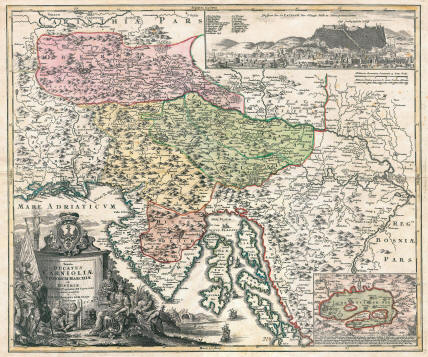
Carniola had an area of 3,857 miles2 (9,990 Km2) and a population of 510,000. Its capital, Ljubljana, was the See of a prince-bishop, with a population of 40,000 and it was known to the Romans as Aemona. It was destroyed by Obri in the 6th Century. Carniola was divided into (map below) Upper Carniola (Slovenian name: Gorenjska), Lower Carniola (Slovenian: Dolenjska), and Inner Carniola (Slovenian: Notranjska). The Carniolan Parliament building (below) is now the University of Ljubljana.
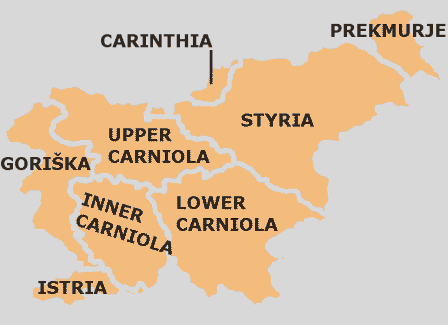
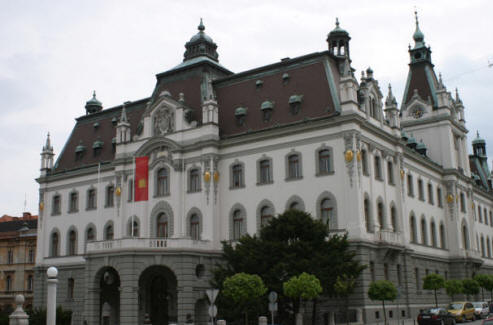
In 1918, the duchy ceased to exist and its territory became part of the newly
formed State of
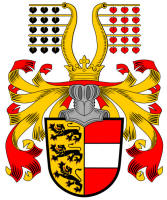
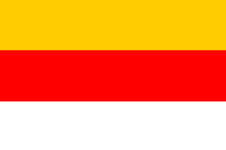 Slovenes, Croats and Serbs and subsequently part of the Kingdom
of Yugoslavia. Below left is the coat of arms of Slovenia when it was part
of Yugoslavia.
Slovenes, Croats and Serbs and subsequently part of the Kingdom
of Yugoslavia. Below left is the coat of arms of Slovenia when it was part
of Yugoslavia.
Along with Carniola, came a small southern piece (above map) of the old Duchy of Carinthia (German: K�rnten) (coat of arms left, flag right.) The larger part of Carinthia remained in Austria after WWII (red in map below.)
.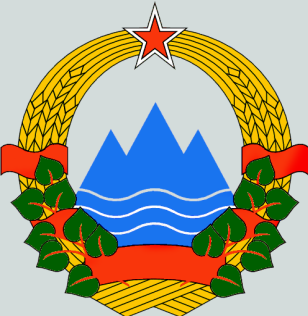
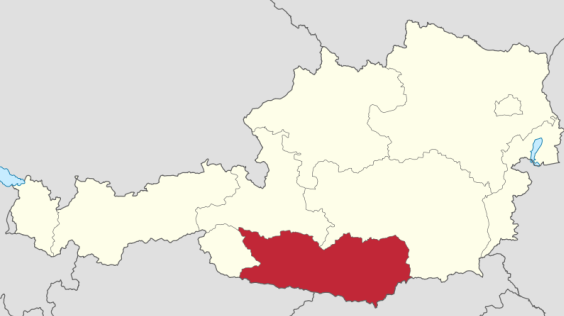
The insignia of the
Duchy of Carniola has had an important and lasting impact on Slovene national
symbols. Thus, the white-blue-red combination of the flag ![]() of the Duchy of
Carniola (below left) is in use today as the official color scheme of the flag of the
Republic of Slovenia.
of the Duchy of
Carniola (below left) is in use today as the official color scheme of the flag of the
Republic of Slovenia.
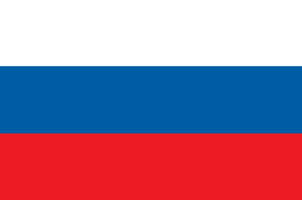
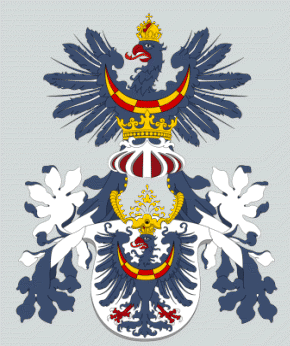
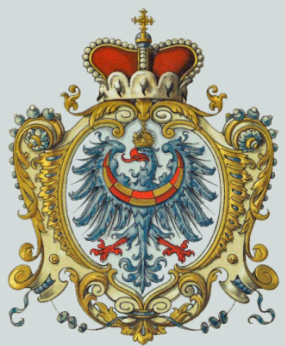
The old coat of arms of Carniola is above center. The Hapsburg coat of arms (above right) served while they were controlled by Austria. Today's coat of arms (below left) is a heraldic composite, incorporating the 3 stars of the Counts of Celje, the Carniolan colors and the image of the Slovene holy mountain Triglav (below center.) The mountain is even displayed on the Slovenian 50 Euro cent piece. We will climb near it later.
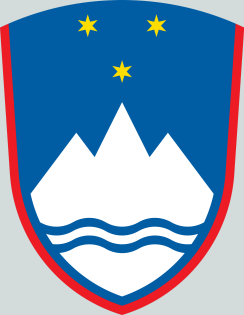
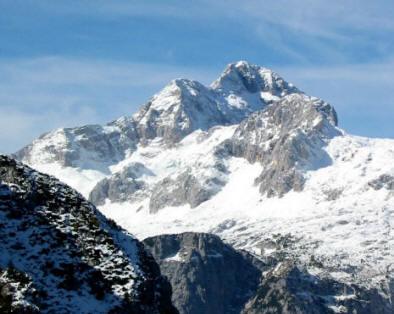
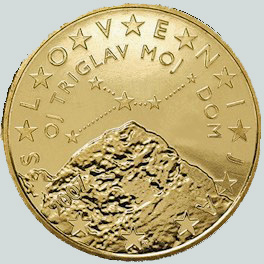
Below left is the previous Communist flag of Slovenia and the ceremony they had with the long pennant flag celebrating their declaration of independence on June 26, 1991
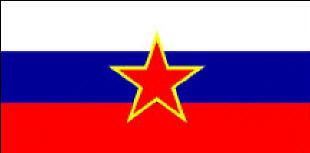
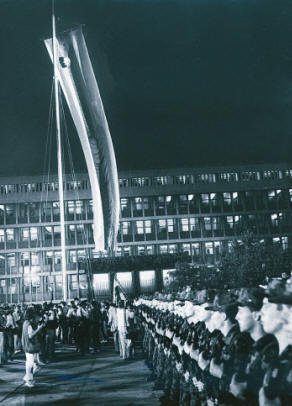
Most Americans know little about this historic region of Carniola and how it is the basis of this modern 20-year-old country of Slovenia.
The population of the city of Postojna is 14,581 with an area of 104.2 mi2 (269.9 Km2) and a density of 140/mi2 (54/Km2.) The entire municipality has a typical karst landscape. Postojna Cave was first described in the 17th Century by Valvasor and a further major part of the cave was discovered in 1818. Electric lighting was added in 1872, increasing the cave system's popularity. A second popular tourist attraction, nearby is Predjama Castle, a 16th Century castle built in the mouth of another karst cave. We will visit it today.
Johann Weikhard von
Valvasor
(below left) is a very important person to the Slovenians.
The "Glory of the Duchy of
Carniola" (German: Die Ehre de�
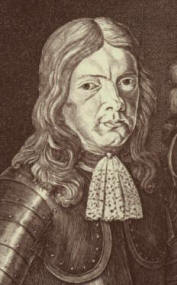 Hertzogthums Crain, Slovene: Slava
Vojvodine
Kranjske) is Valvasor's most important work on the history and
natural history of his homeland, Carniola. Concerned that outsiders did
not know his region well enough, he undertook the
Hertzogthums Crain, Slovene: Slava
Vojvodine
Kranjske) is Valvasor's most important work on the history and
natural history of his homeland, Carniola. Concerned that outsiders did
not know his region well enough, he undertook the 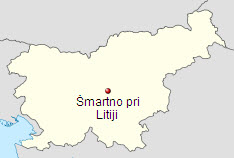 story of Carniola in
words and pictures. He installed a copperplate workshop at his 16th
Century Bogen�perk Castle
(below right) located in �martno pri
Litiji in central Slovenia (right) and used it to publish collections of his work.
Written in German, his work was published in
1689 in Nuremberg in 15 volumes (below left.)
story of Carniola in
words and pictures. He installed a copperplate workshop at his 16th
Century Bogen�perk Castle
(below right) located in �martno pri
Litiji in central Slovenia (right) and used it to publish collections of his work.
Written in German, his work was published in
1689 in Nuremberg in 15 volumes (below left.)
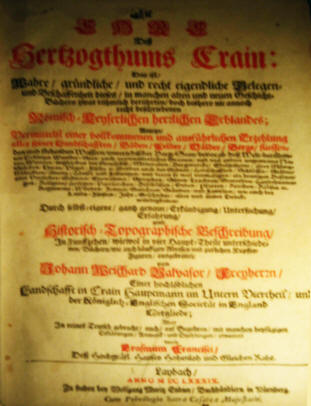
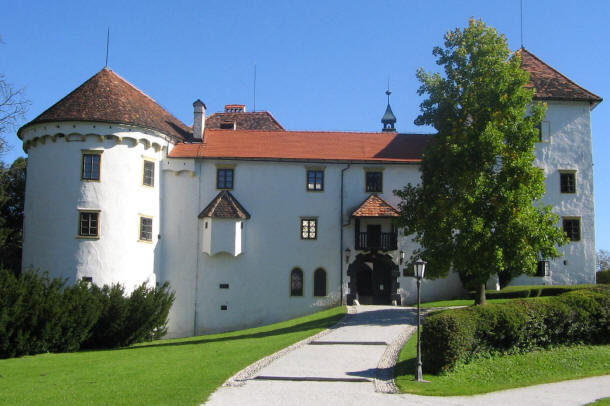
It was lavishly illustrated with 528 copperplate engravings. It is an encyclopedia of the history, customs and folklore and the topography of a region that makes up a large part of present-day Slovenia. It was only recently translated into Slovenian.
Enough background; back to the trip.
I woke at 2:45 AM and Marcia woke me at 7 AM so I could run early. I got up at 7:50 and got into my running gear. Below left is the very modern lobby of the hotel. On the right shows the touc controls for the elevator which are as modern as I have seen.
.jpg)
.jpg)
By 8:30 I was running out from the hotel and soon wound up on a road out of town. The city is really not that big. As I turned this big bend in the road I saw another one of these large mirrors that help drivers spot oncoming cars. Here is a typical Postojna manhole cover.
.jpg)
.jpg)
I took a photo of this huge banner on the bridge announcing the "Erazmov Vite�ki Turnir" at Predjamski Grad and only found out later in the day that it said "Erasmus Knight's Tournament." Note the dates are tomorrow and the next day, so we will obviously miss it by 24 hours. More on this later.
As I kept running, I came across the chapel dedicated to Saint Lazarus and...
.jpg)
... next to it the town cemetery both of which belong to the parish of St. Stefan.
I then came across the entrance to this inviting little wooded park, so I decided to run through it.
.jpg) The
entry sign (below left) says "Srednja gozdarska in lesarska �ola
Postojna" which means "Forestry and Wood Middle School in Postojna."
There was a display titled "Bolezni in poskodbe dreves" meaning "Diseases and
injuries of trees" with pictures of different tree maladies (below right.)
The
entry sign (below left) says "Srednja gozdarska in lesarska �ola
Postojna" which means "Forestry and Wood Middle School in Postojna."
There was a display titled "Bolezni in poskodbe dreves" meaning "Diseases and
injuries of trees" with pictures of different tree maladies (below right.)
.jpg)
.jpg)
There were these photos of tree diseases and injury (above & below.)
.jpg)
.jpg)
I then came across a memorial...
...which is for Karel Levičnik (1900-69.) The best translation I could get for the inscription was: "Commandant-General, War artillery, 4th Armada Assembly's deputy. Famous in Postojna County." Below they had this unique huge wooden and steel ant structure for kids to climb on. It was neat.
They have these recycling bins for ostanek odpadkov (residual waste,) embala�a (packaging) and papir (paper.)
.jpg)
I left the park and on the way back, at 9 AM, I got photos of St. Stefan's church. This parish church in the town is under the Koper Diocese. It was nice.
.jpg)
At 9:10 I got back into town and stopped and had a cappuccino at Sla�cicarna (cake) Majlont [Trza�ka 2] which only cost �0.9 ($1.25,) which is not bad. It was right near the hotel and an easy place to people watch right in the main Titov square.
At 9:50 I headed back to the room and took a nap. I woke at 11:15, took a shower and packed up. At 12:00, I loaded the car, got on the free WiFi in the lobby and did my email and the crossword. At 12:30 I took the stairs (below) and then checked out of the hotel. I had much help from Andreja Posega (below;) she was just wonderful and helped make our stay here a pleasure. We got a 10% discount but had to pay �10 for parking. I would definitely recommend a stay at this hotel.
With the car loaded, I then wanted to go out and see more of the city. I started from Hotel Kras (below left) and the building nearby housing the eatery Restavracija Proteus (below right.)
In the center of Titov Square there is this odd undulating sculpture. I got a shot of it from both sides. You can see my cappuccino place on the corner of the building (below right) with the blue awning.
Nearby the square was this large modern apartment building (below left) and further down I came across this large Vilhar School (below right.)
The school is named in honor of the Slovenian poet Miroslav Vilhar.
.jpg)
.jpg)
The inscription on the memorial says "Cujte gore in bregovi da sinovi slave smo" which means
"Hear, mountains and hills that were the sons of slaves!" Vilhar was a versatile
artist; a composer, poet, playwright, and publisher who helped awaken Slovenian nationalism.
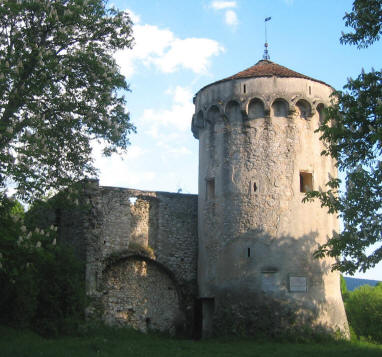 He was born in 1818 in the Postojna Planina
and studied law in Vienna and
He was born in 1818 in the Postojna Planina
and studied law in Vienna and
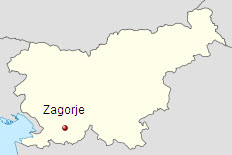 Graz,
where he became a composer. In 1864 he settled permanently in the Kalc
Grad (right,) a 17th Century limestone castle in Zagorje, built by the noble
house of Steinberg . Today it is abandoned.
Graz,
where he became a composer. In 1864 he settled permanently in the Kalc
Grad (right,) a 17th Century limestone castle in Zagorje, built by the noble
house of Steinberg . Today it is abandoned.
Later the poet became the inspiration for all the developments in 1869. On May 9th, he and his supporters and friends organized the famous "Pivka camp" at Kalcu, which was attended by about 7,000 people. This camp was the biggest political event in Pivka up to then and for decades later. The quotes that appear in a number of triumphal arches in Slovenia are his verses such as the one inscribed above on his school monument.
As I went along, I then came across another monument of a partisan shooting a rifle...
... with the inscription: "Padlim borcem za svobodo borbi proti fasizmu" which means "For the fallen defenders of the freedom struggle against fascism."
I got back to the hotel and met Marcia. We were ready to head out but Marcia wanted some lunch so at 1:50 we bought two breads and a hot dog brioche with a water at Pekarna Brilijant [Ljubljanska 1.] I got some to eat later.
We sat while Marcia had the hot dog brioche for her lunch. Here is a photo of Titov Trg I had taken from our hotel window.
They certainly love the little Proteus, its everywhere.
.jpg)
Below is an excellent map of the city that I photographed. I left it large for anyone who might want to download and print it out if planning to travel there.
.jpg)
At 2:10 I drove the 7.5 miles (12 Km) to the little village of Predjama (map) and then
up to Predjama Castle
(Slovene: Predjamski grad or
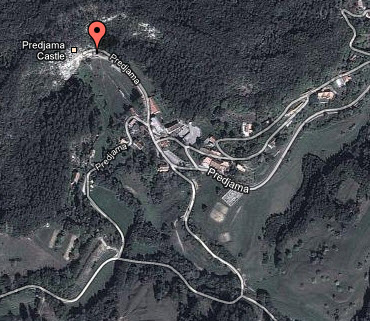 Grad
Predjama, German: H�hlenburg Luegg, Italian: Castel Lueghi) which is a
Renaissance castle built within the mouth of a cave. The castle was first mentioned in the year 1274 with
the German name Luegg, when the Patriarch of Aquileia built the castle in Gothic
style. It was built under a natural rocky arch high in the stone
wall to make access to it difficult. It was later acquired and expanded by
the Luegg noble family, also known as the Knights of Adelsberg (German for
Postojna).
Grad
Predjama, German: H�hlenburg Luegg, Italian: Castel Lueghi) which is a
Renaissance castle built within the mouth of a cave. The castle was first mentioned in the year 1274 with
the German name Luegg, when the Patriarch of Aquileia built the castle in Gothic
style. It was built under a natural rocky arch high in the stone
wall to make access to it difficult. It was later acquired and expanded by
the Luegg noble family, also known as the Knights of Adelsberg (German for
Postojna).
We finally arrived at the area where you can park and we were right next to this little 15th Century church called the Mother of Sorrows.
We tried to go inside but it was locked. We went around to the backside and I got this shot of the interior through a window. Interestingly, it was consecrated by Pope Pius II in 1449.
.jpg)
We walked up closer to the castle and came across this tree. Here is the story.
.jpg)
In 1478 the castle became the property of
the knight Erazem Lueger. He was probably the most famous inhabitant of Predjama
Grad. In 1483 he killed the commander of the Imperial army, Marshall Pappenheim at the Vienna court during
an argument. Pappenheim was a relative of the Holy Roman Emperor
Frederick III (1452-93) (below,) so
Erazem fled to his castle here to
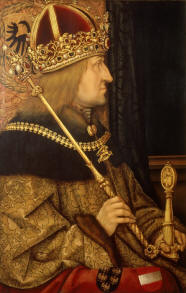 escape punishment.
Erazem then started raiding and robbing Frederick's territories. The
Emperor ordered Gaspar Ravbar, Lord of Trieste, to lay siege to the castle. Ravbar tried to
starve Erazem to death but was surprised to see that Erazem seemed to have an
unlimited supply of fresh food, especially cherries which he loved hurling at
Ravbar in defiance.
He held out for a year and a day when finally Erazem was killed by a cannonball while sitting on the toilet
(see below.) He was betrayed by one of his servants who put a flag up when
Erazem hit the can. Later it
became known that Erazem had gotten his food through a secret passage through
the caves. He is said to be buried under the above tree. Quite a
story.
escape punishment.
Erazem then started raiding and robbing Frederick's territories. The
Emperor ordered Gaspar Ravbar, Lord of Trieste, to lay siege to the castle. Ravbar tried to
starve Erazem to death but was surprised to see that Erazem seemed to have an
unlimited supply of fresh food, especially cherries which he loved hurling at
Ravbar in defiance.
He held out for a year and a day when finally Erazem was killed by a cannonball while sitting on the toilet
(see below.) He was betrayed by one of his servants who put a flag up when
Erazem hit the can. Later it
became known that Erazem had gotten his food through a secret passage through
the caves. He is said to be buried under the above tree. Quite a
story.
In 1567 the castle was bought by Hans Kobenzl, an Austrian knight from K�rnten (Carinthia.) He rebuilt and enlarged the castle and what we see today is mostly the result of this building campaign. His descendants remained owners of the castle until 1810. Because this important noble family resided mostly in Austria, the castle was kept in good shape but escaped further large rebuilding. Two more owners followed until the castle was confiscated by Tito for the Yugoslavian state after World War II.
[The 6 outlined photos below are thanks to Marko's excellent website on castles. He is a Dutch policeman who motorcycles around the EU photographing castles. Good Job.]
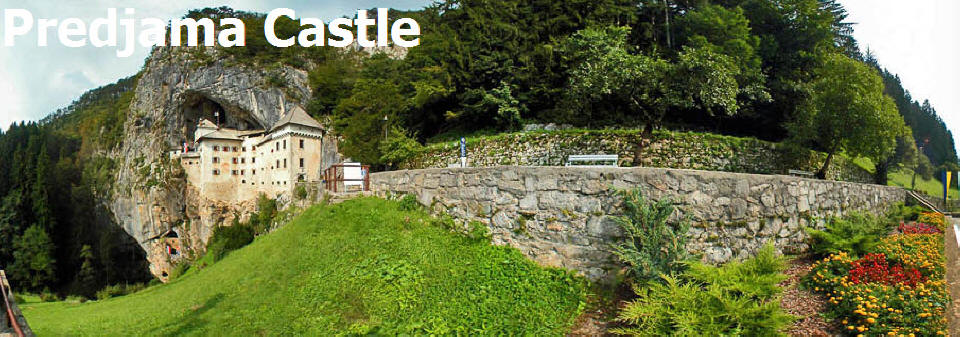
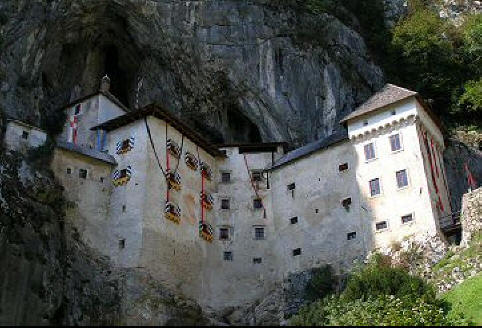
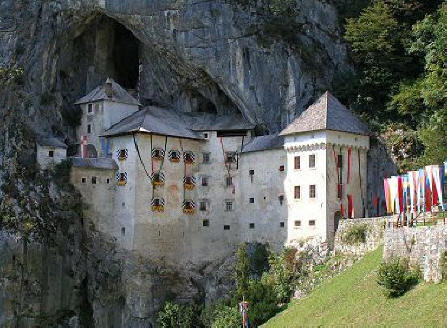
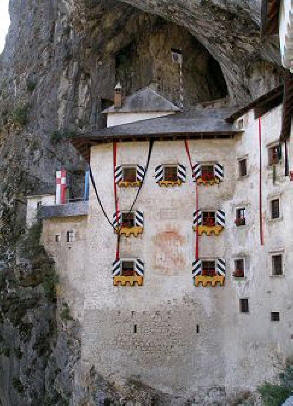
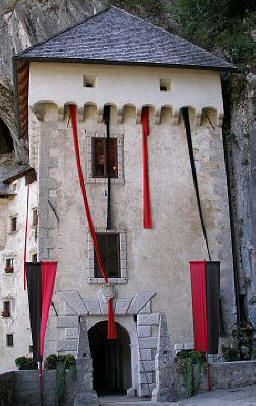
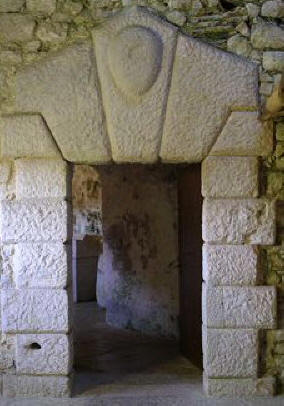
We headed up the long walk to the castle, past the touristy stores.
It is a very impressive looking castle.
Half way up the hill they had a conveniently placed stone bench and Marcia decided to use it to rest for a few minutes. It was quite a climb.
Then I looked down into the little valley on the left side and saw what looked to me like a jousting arena. You can just picture the knights on their horses.
This is the viewing stand for the Prince. Note the 3 stars and the Triglav.
It was then I realized
.jpg) what
the big banner I saw in town was about. Tomorrow will start a two day
knight's (vite�ki)
jousting tournament (turnir) here celebrating our friend Erazem. It was
confirmed by the postcard I later found (below) and talking to the staff later.
We sure lucked out and missed a bullet here, since this place will be a crowded
madhouse tomorrow. Today it is nice and quiet.
what
the big banner I saw in town was about. Tomorrow will start a two day
knight's (vite�ki)
jousting tournament (turnir) here celebrating our friend Erazem. It was
confirmed by the postcard I later found (below) and talking to the staff later.
We sure lucked out and missed a bullet here, since this place will be a crowded
madhouse tomorrow. Today it is nice and quiet.
.jpg)
On the right hand side of the walkway they had wine grapes growing on the hill. These were Muscat Bleu.
A little further up they had a convenient Gostilna (place to eat) with a beautiful view of the Grad and the cave.
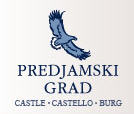
We finally arrived at the castle ticket booth at 2:20 and when I went to buy the tickets, they told me that the tickets I bought for the cave yesterday included the castle as well (within 48 hours.) This was a nice surprise and saved us �19 ($26.79.) I had to get a shot of her in front of the castle.
.jpg)
.jpg)
.jpg)
They also offered ticket packages that included a meal and there were three different menus to choose from. We approached the castle entrance.
We began our tour of Predjama Grad by crossing the drawbridge.
The stone above the entry door (Marcia's above, mine below) is dated 1583 and has a crest above it. The pennants (below) are all ready for tomorrow's festivities.
While you cross the drawbridge, these are the views of the valley below.
As you enter the castle they have this large description of the history of the castle which is quite interesting.
.jpg)
Here is a closer look.
.jpg)
.jpg)
.jpg)
Above are hypothetical reconstructions of how the castle may have looked over the years. Left to right is the 12th, 13th and the 14th Century.
.jpg)
.jpg)
Above left is at the end of the 15th Century and on the right, after the renovations from 1570-85. Below is the historical introduction to the castle ...
.jpg)
... as well as a description of Karst landscape and the archeology of the area.
.jpg)
.jpg)
There also were vertical (left) and horizontal (right) maps of the cave system behind the castle. It is the second longest in Slovenia, after the Postojna Cave.
.jpg)
.jpg)
You can also tour this cave (red line, above left) and take a guided lantern tour farther back (tan line,) but we had enough caves and skipped it.
Since these countries we are visiting are full of castles and we only took the time to tour two of them (this one and one in Slovakia,) I will thoroughly present what we have seen. They are probably the best examples. Here is the map of the ground floor.
.jpg)
.jpg)
We entered here on the ground floor into entrance hall (1) (below left) and the hallway with a sarcophagus (below right.)
Below is the guardroom (0.)
.jpg)
On the wall was a painting of the famous knight and a window view of the valley.
Because there were a bunch of families with noisy kids in front of us and a large tour group coming in behind us, I told Marcia we should hurry up the stairway and get to the upper floors.
.jpg)
.jpg)
Now we were up the stairs (3a) near the walkway (3) and looked around this level. We saw the vestibule with the water container (28) and a bucket of wood.
.jpg)
.jpg)
Then we entered the large Knights Hall (29.) I did this with PhotoStitch.
.jpg)
Here is the Knight on his throne ready for audiences with visitors.
We then went up the stairs to the second floor.
.jpg)
.jpg)
Below left is the old route to the Prince's Room (26) and on the right is the torture chamber (8) and natural dungeon cavern (9) with a dummy hanging.
.jpg)
Marcia tking pictures in the walkway (5) and another view out the window.
.jpg)
We then entered the Main Hall Dining Room (25.)
Next to that was the kitchen with an open hearth and mechanical rotisserie (27.)
We then went up another flight to the third floor.
.jpg)
.jpg)
We looked into the Anteroom (11) with it's modern wood paneling and floor.
We went out on the balcony (12) and got a grand view.
Here is the famous water closet (13) or toilet where Knight Erazem got beaned with a cannonball. Below right is Marcia's shot of a repaired stone coat of arms.
.jpg)
Below is the upper hall room, the Prince's room and master's living quarters (15.)
.jpg)
There were many things on the wall here. Below is the Coat of arms of the Cobenzl (Koblenzl) Counts.
.jpg)
.jpg)
There is a painting (left) and a marble bust (right) of John Casparus, a Count of Coblenzl, probably a son of Hans Koblenzl.
.jpg)
.jpg)
Below is the Coat of arms of the Coronini Counts.
.jpg)
.jpg)
And finally the massive Coat of arms of the Windisch-Graetz Princes.
.jpg)
.jpg)
We then entered the Chapel of St. Anne (16) with its little altar and pews.
Behind the chapel is the sacristy and chaplain's quarters (17) with a covered bed which was rather small.
At the very end, over the main entrance is the Guard tower attic (6) with holes below the roofing to pour boiling oil on attackers.
.jpg)
We then climbed to the fourth floor.
.jpg)
Here there are the attic quarters of the garrison (20.)
We finally made it to the fifth and final floor (six flights up.)
.jpg)
Here is the drawbridge leading into the part of the castle inside the cave (23) and a stairway up to a lookout hole in the cavern wall.
Below are photos from various parts of the castle that I can't specifically place.
.jpg)
Below are Marcia's shots of the antlers as well as ...
... the bell and some cooking pots.
We meandered our way back to the ground floor to explore what we missed by racing upstairs at the beginning.
.jpg)
.jpg)
Arriving back on the ground floor we explored the base of the castle with a covered inner courtyard (38) for tethering horses. Little kids sure like exploring all the holes.
Marcia got these shots below.
Here are some of the stonier parts.
Looking back at the cliff, you can see the rock formations and openings dissolved from the limestone. You finally reach the area with a stair walk that goes up into the cave. Marcia (below right) walked all the way up with me.
.jpg)
At the top there was a well and stairs leading farther into the cave (below left) but the gate was locked. Turning around and looking back down (below right) is quite a sight with that big gaping hole.
.jpg)
.jpg)
Below are views of the ceiling up here.
.jpg)
.jpg)
We saw the cellar (36) then went into this room (37) where they had a little store selling goods.
The pretty young lady poured me a sip of the pear liqueur labeled Samostanska (monastery) Vilijamovka (28% alcohol) and at 2:30 I bought a liter bottle for �8.49 ($12.) The label states that "product is not suitable for children."
.jpg)
At 2:55 we were finished with the tour and I bought a pin and at 3:40 we stopped at the final desk and were offered our photo to buy. You can see the wall of photos and you have to find yours.
.jpg)
Vanja (below right) was very convincing that we needed to get it. This one wasn't bad so I got it for �6 ($8.45.) She also told us we were smart missing the Erazem tournament tomorrow because it will be crazy here. She was very nice.
We walked by the eateries on the way to our car. Had to get this shot of the Union beer sign.
.jpg)
At 3:45 I sat in the car and ate the 5 little ham and mozzarella sandwiches I had bought earlier. I was really hungry. At 3:55 I drove back to Postojna but did not want to take the freeways which went way north first and then east. Instead I decided to meander our way through the smaller towns and get a chance to see the countryside. We pretty much took the hypotenuse (as the crow flies) instead of the the two sides of the triangle. Of course this was much slower.
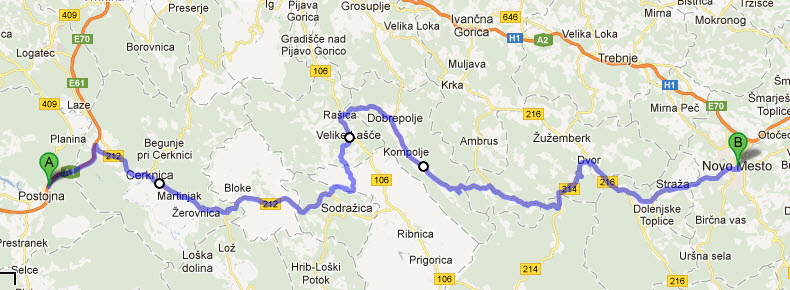
At 4:10, after 10 miles (16 Km,) we passed Cerknica. Then at 4:35, 20 miles (32 Km) later we went through Velike La�če. I drove another 141 miles and these are various shots of the countryside and towns we went through.

.jpg)
%20(2).jpg)
We even had to stop for a train crossing the road.
Can you see the little building on top of the hill? Below is a zoom-in of it.
.jpg)
![]() We arrived in the city of Novo Mesto for a
total of 171 miles (275 Km.) The GPS helped us get into downtown Novo
Mesto and at
6:15 we checked into
Hotel Krka
[Novi Trg 1,
We arrived in the city of Novo Mesto for a
total of 171 miles (275 Km.) The GPS helped us get into downtown Novo
Mesto and at
6:15 we checked into
Hotel Krka
[Novi Trg 1,
![]() +386-7-394-2100,
booking.hotel.krka@terme-krka.si,]
again found on Booking.com. This turned out to be one of the worst
bookings. Not because it's not a nice hotel right in the center of the city
but because the management of this hotel are LIARS and make their poor staff perpetuate the lies over and over again to every guest that checks in.
They advertise air conditioned rooms and free parking.
+386-7-394-2100,
booking.hotel.krka@terme-krka.si,]
again found on Booking.com. This turned out to be one of the worst
bookings. Not because it's not a nice hotel right in the center of the city
but because the management of this hotel are LIARS and make their poor staff perpetuate the lies over and over again to every guest that checks in.
They advertise air conditioned rooms and free parking.
.jpg)
When you complain that your room is boiling hot, Peter tells me that the AC just went down in a couple of rooms and they are working on it right now. When you ask where the free parking is, Peter tells me their lot was filled up by tour buses and I would have to park in the street and pay a fee which he can discount with a voucher. How nice. He's very sorry on both counts. Both are lies. Below in the entrance.
The AC is either non-existent or has been broken for a long time and will not be back on during our stay. Why would a hotel fill their parking area with buses so that guests have no place to park? I finally got two of them to admit that they are told to say this. While I was checking in, another guest was screaming at them about the parking. It was quite a ruckus. Hopefully, management will change and make this a nice place to stay. Below is the lobby and a sculpture in the corner.
.jpg)
They gave us room #226 which would have been nice if there had been AC.
.jpg)
.jpg)
It is certainly a clean and adequate room.
.jpg)
Fed up with them and the hot room, I went outside and found we were near this very large central expanse surrounded by buildings called Novi Trg (below.) I went into the nearest one on the right and found it was full of shops.
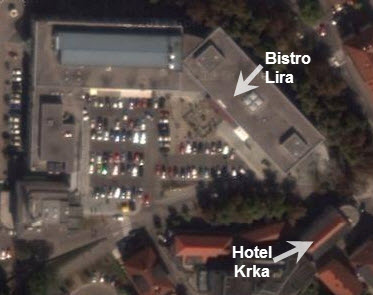
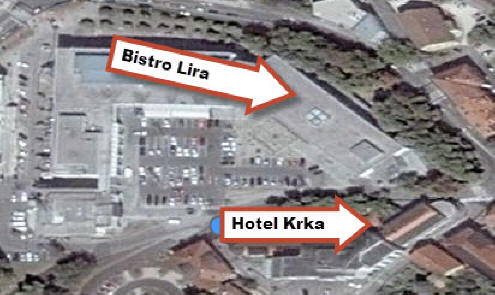
Three-fourths the way to the end (below left, on right side,) I stopped
at Bistro Lira [Ko�tialova ulica 44a (Novi Trg 10,)
![]() +386-6-411-1076]
(below right) and at 6:55, I had two glasses of sparkling water while I relaxed and watched
the people. The area wasn't all that pretty, with all the parked cars in
the center.
+386-6-411-1076]
(below right) and at 6:55, I had two glasses of sparkling water while I relaxed and watched
the people. The area wasn't all that pretty, with all the parked cars in
the center.
Marcia had texted me that she was ready, so I went back to the hotel and joined her at the little bar they have (below right) next to the reception desk (below left.)
We had a beer and wine and at 7:00, Marcia went up and paid for a parking voucher (below left) for �4.5. Then we got the car and drove to the river where we were recommended for dinner (by Peter and the tour book.)
At 8:30 we had
.jpg) dinner at
Gosti�ce Loka [�upančičevo sprehajali�če (Zupančič promenade,)
dinner at
Gosti�ce Loka [�upančičevo sprehajali�če (Zupančič promenade,)
![]() +386-7-332-1108.] As you can see from the map below it wasn't very far away from
our hotel but we didn't want to take a chance walking around late at night on
our way back. I was a little doubtful about the town and how safe it was
late at night. Knowing us, we would be the last people to leave the
restaurant.
+386-7-332-1108.] As you can see from the map below it wasn't very far away from
our hotel but we didn't want to take a chance walking around late at night on
our way back. I was a little doubtful about the town and how safe it was
late at night. Knowing us, we would be the last people to leave the
restaurant.
.jpg)
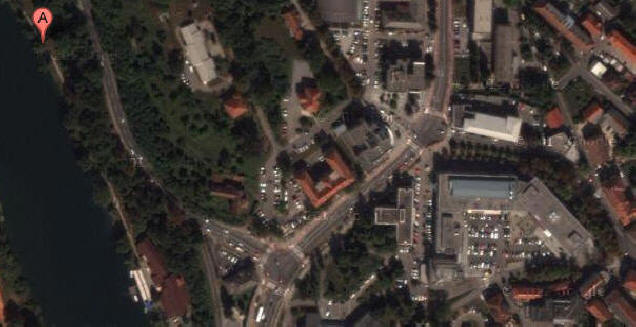

This place is perfectly situated right on the river.
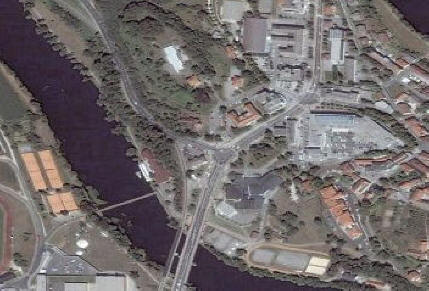
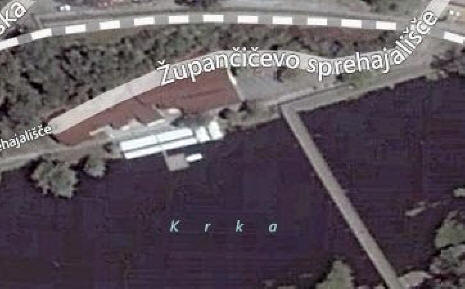
What a lovely evening and a great spot. Hope the food is good.
There was no one eating inside so we were led to a table on the veranda.
Here is the view of the walking bridge to the left and a view of the river to the right.
Then our waiter brought us their extensive menu in Slovene and English. They had a full bar with plenty of booze.
.jpg)
.jpg)
.jpg)
.jpg)
And, of course, plenty of La�ko and Union beer on tap and even Red Bull.
.jpg)
.jpg)
.jpg)
.jpg)
.jpg)
.jpg)
.jpg)
.jpg)
.jpg)
.jpg)
.jpg)
.jpg)
.jpg)
.jpg)
.jpg)
.jpg)
.jpg)
.jpg)
.jpg)
.jpg)
.jpg)
.jpg)
.jpg)
.jpg)
.jpg)
.jpg)
.jpg)
.jpg)
.jpg)
.jpg)
With such an extensive menu, it was hard to make decisions. We decided to share a plate of calamari fritti (ocvrti lignji) with French fries to start.
.jpg)
I had a bottle of La�ko beer and later a Bandidos Ice ("refreshing taste of Caipipinho") while I enjoyed an entree of penne with prosciutto, cream and cheese (peresniki s pr�utom smetano in sirom.)
Marcia had a carafe of Prus sivi Pinot blanc with her entree of grilled salmon filet (lososov file na �aru) with rosemary roasted potatoes (� ro�marinom with pecen krompircek.)
.jpg)
I finished with a cappuccino and a gelato limoni (sladolad kepica.)
Our waiter was Borut (not Borat) and he took very good care of us the entire evening. We rated the dinner "Good to Very Good" and the total bill was �39.6 ($56.)
%20(2).jpg)
.jpg)
I went inside and took a few photos of the facilities interior.
I think they might also have a hotel here.
.jpg)
.jpg)
.jpg)
We picked up and left and at 11:00 we went back to Bistro Lira near the hotel for a nightcap and who shows up but our waiter, Borut. He buys me a glass of wine and we talked politics for quite some time. He was very interested in the differences between liberal and conservative. We had an enjoyable conversation.
Marcia had a glass of chardonnay and I had a Reican wine by (according to Borut) a local vintner named Joze Prus from Metlika, just 22 miles (35 Km) from here. Our waitress was Seka and she took good care of us.
We finally slid out of there and hit the sack in the warm room.
[Since this is Diario #10, I will now work on Italy 1997 which I have just discovered will involve scanning paper photos and taking photos from 15 year old video tape. Also the diaries I kept on the Palm back then were rather thin. I hope my memory is good. After that I will add a new page to each trip before returning here.]
Kenneth J. Hoffer, MD
Novo Mesto, Slovenia
Sent 7-19-2012
If you enjoyed these travels or wish to add comments on the places we visited
Please Leave Me a Message by clicking the spinning @ sign below.

